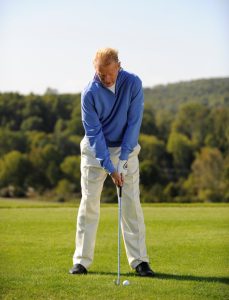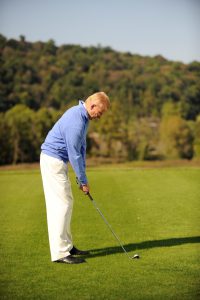Four Bottom-Up Balance Strategies

by Dr. T.J. Tomasi, Keiser University of College Senior Faculty and Director of Research
One essential job your brain has is monitoring your balance so that at the first sign of falling, it will take corrective action to keep you upright. When it comes to golf, this protects your body but ruins your golf swing. To stay down and through the ball helps to understand why you come up and out of the shot as you lose your balance. Four basic balance strategies are employed by your balance system depending on the severity of balance disruption, and they’re activated from the ground up, i.e., feet first.
Ankle Strategy: The Sway
At address, your body is an inverted triangle balanced on your ankles which serve as pivot points where even a small force, such as poor weight distribution, triggers a swaying motion to reestablish balance. In golf, you must learn to eliminate the body sway in favor of rotation.
Hip Strategy: The Hinge
If the imbalance is not corrected at the ankle level, the hips are called into play. When the base of support is fixed – as in the golf swing – the upper body uses the hips to regain balance by hinging or bending the body forward and back. In golf, your fat and thin shots are caused by a response: your spine hinging toward (fat shot) or pulling away from the ground (thin shot), depending on the initial imbalance cue. You remain upright (the balance system worked), but due to the adjustments in the balance system, the shot is either fat or thin, depending on the system input.
Arms/Shoulders Strategy: The Flail
The next level of the balance system is the arms/shoulders that stabilize your center of mass by making use of a group of perfectly designed joints needed for mobility, including the wrist, elbow, and shoulder. However, to play consistent golf, the player must understand how the joint system works under stress. For example, when the arms are thrust outward during the downswing to regain balance, you’ll hit it on the club’s heel. It’s exactly the opposite when you pull your arms back and adjust closer to your body to redress the opposite problem – a toe shot.
Step Strategy
When the only way to stay upright without falling is to reconfigure the support base by changing location, you take a step during the downswing to recover equilibrium. It’s the same step you take when you walk, which is a process where you lose your balance and regain it by stepping. You see this most often in youngsters just starting in golf who simply respond to an alarm set off by the balance system. The step prevents the fall. You must fix this ‘top level’ balance problem before anything else. Hold your finish for a count of three if your swing is so far off that you can’t keep your feet in place.
Takeaway
And here’s the huge point: Once your balance system is triggered, you have no choice but to obey, which is why your teacher can say, “don’t lift your head or don’t dip down,” but you can’t stop doing it because its function relates to an ancient and beneficial system that has protected humans for eons. Thus, the best way to deal with your balance recovery system is to be sure you don’t trigger it—and it all starts with your weight distribution at setup.
Distribution at Address
The three critical balance joints [ankle, knee, and hip] are directly aligned and at their best when stacked. Like our model below, your weight should be distributed from the balls of the feet back to the heels, as the arrow indicates. To ensure you distribute your weight correctly, curl your toes at address without rocking back on your heels.
















